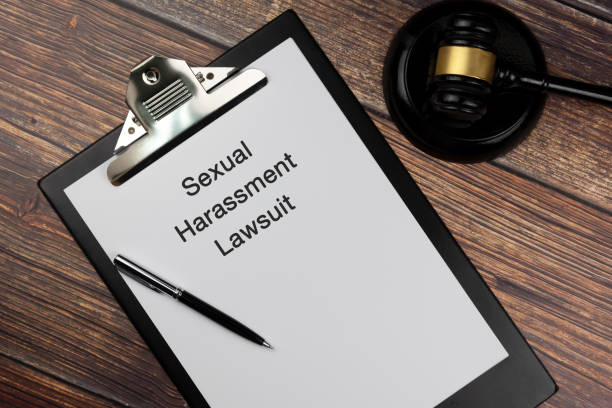
What is victimisation in the workplace and how it affects you
To be a victim of sexual harassment is incredibly difficult and for some people traumatic. Unfortunately, not all employers and workplaces are responsible in their duty to protect and aid their employees. In some circumstances when an employee complains of sexual harassment a workplace will become more toxic and further detriment the victim.
This is what it means to be victimised or suffer from victimisation. However, to complain regarding workplace issues is a protected right for employees under the Fair Work Act 2009.
Victimisation is illegal in all states and jurisdictions and employees will be protected by either the Fair Work Act or state anti-discrimination legislation. Unfortunately, the Australian Human Rights Commission have stated that victimisation of people who report sexual harassment is increasing (source).
Therefore, more than ever employees would be aware of their workplace rights and the responsibility of their employer.
Identifying victimisation
Victimisation is a negative reaction from a company or employee after a victim of sexual harassment has complained or informed their employer of what has occurred. There must be a detriment suffered as a result of a complaint, or an employee had complained on someone else’s behalf. The most obvious type of victimisation is for an employee to lose their job. However, a multitude of things can happen, including but not limited to:
- Demotion, or a change in job description that is worse than an employee’s current job.
- Threats that an employee will be fired or demoted.
- Given a formal warning.
- Bullying or harassment from other employees
- Ridiculing
- Victim blaming
- Isolation

How an employer meant to protect their employees
Before a complaint is even made, an employer has the duty to implement reasonable steps to prevent employees from being sexually harassed or contravening any laws that would result in sexual harassment. Typically seen through workplace policies, online training, or mandatory seminars and information nights.
Once a complaint of sexual harassment has been made to the company, they have a duty to investigate the complaint. At a minimum, all complaints of sexual harassment must be investigated regardless of whether the employer thinks it is necessary.
The investigation must be procedurally fair to prevent further victimisation. This would include giving the affected employee a periodic update of the investigation and when possible a timeline of completion. Genuine opportunity to provide a statement. And that the investigator is a neutral third party.
As an employer, they have a responsibility to prevent sexual harassment it is likely for a supportive workplace to separate the affected employees entirely. If a perpetrator of sexual harassment is not terminated, then the company may (when possible) separate the employees into different departments or locations.
Majority of companies, at a minimum, are happy to separate the affected employees into different management lines. However, the most appropriate action will depend on the circumstance of the sexual harassment itself.

Signs of a toxic workplace
If an employer has done none of the above actions, or only a select number of actions, then it is likely they are a toxic workplace that does not care for their employees. To victimise an employee is the definition of a toxic workplace.
Furthermore, from December 2023, employers have a legal obligation to take proactive measures to prevent hostile work environments from forming. Therefore, an obligation to prevent sexual harassment and victimisation within their own right.
If you feel like you are an employee who has been victimised and/or works in a hostile and toxic work environment then you may want to consider finding different employment. However, this will be highly dependent on each employee’s surrounding circumstance and whether finding alternative employment is a viable option. Even if it is not an option right now, opportunities may present themselves in the future.
What do I do if I have been victimised?
Depending on the circumstance of the sexual harassment there are a number of options an employee can take if they are victimised. However, there is no one claim that will discuss the victimisation by itself. Victimisation is incorporated into a number of claims.
The most time sensitive option is going through the Fair Work Commission (FWC). The FWC also has the most restrictions on what claims can be brought forward. In a situation where there is both sexual harassment and victimisation in the workplace, then a General Protection Application (F8/F8C) will likely be the most appropriate choice. This claim essentially protects against victimisation, or what’s called ‘adverse action’.
A General Protections application is appropriate when an employee had exercised a workplace right, and because of that their employer had decided to retaliate against them. What is considered retaliation or adverse action is similar to victimisation.
The list of victimisation above can also be considered adverse action. Additionally, a workplace right includes making a complaint, becoming a union member, or taking leave. Only when the employer retaliates, victimises, or adversely affects the employee will they be able to go to Fair Work.

The biggest restriction to a General Protections application is when an employee is terminated for making a complaint regarding their sexual harassment. A terminated employee will only have 21 days to lodge a Fair Work claim, starting from the day of their termination.
This is also the case if an employee resigns or was forced to resign. However, if the employee is still employed then there are no time restrictions. Depending on whether the employee is employed or terminated will affect whether they lodge an F8 or F8C.
Other options available
If somebody is unable to go to the Fair Work Commission for whatever reason then there is the Equal Opportunity Commission or state tribunals that can help. The state will affect where a claim needs to go and the process that is followed.
All states incorporate victimisation within their anti-discrimination and sexual harassment legislation. Sexual harassment is typically dealt as a product of sex discrimination and they will typically be seen together in a singular claim. It is not uncommon to have sexual harassment, discrimination, and victimisation on a single claim.
To go through state services – Equal Opportunity Commission, VCAT, and TASCAT etc., is definitely a lengthier process than Fair Work. Due to Covid-19 backlog, most claims will not start the process until 6 to 12 months after the claim was lodged.
Compared to Fair Work that has a turn around of approximately 2 months from start to finish. However, it is more common to have higher figures of financial compensation at state tribunals.
There are a number of factors and restrictions that may affect whether someone decides to pursue a Fair Work or tribunal claim. However, they cannot be done concurrently. An employee may try both avenues, however they have to be done at separate times.
Therefore, it is common to go through Fair Work first as they have greater time restrictions and a shorter process. Then if that is unsuccessful then employees are eligible to try in their state tribunal.

Employee seeks huge compensation
In Styles v Clayton Utz (No. 3) [2011] NSWSC 1452 , Ms Bridgette Styles was an employee and solicitor for one of Australia’s biggest law firms, Clayton Utz. She started her employment in August 2007, and was terminated December 2008 after she had complained that she was sexually harassed at work.
Ms Styles claimed that she was sexual harassed by another co-worker under 28B(2) of the Sex Discrimination Act 1984 (Cth) and then victimised for complaining.
Prior to Ms Styles starting her employment, she had a romantic and intimate relationship with co-worker, Mr Izzo. At this point they were not working for the same employer. Once Ms Styles had begun her employment at Clayton Utz, she and Mr Izzo had consensual sex once.
However, their relationship began to deteriorate once Mr Izzo began making sexual and derogatory comments towards Ms Styles and their mutual coworkers. Ms Styles’s complaints of sexual harassment only began after Mr Izzo started to make unwelcomed comments.
There were allegedly 12 instances of unwelcome sexual conduct from Mr Izzo. Some instances included spreading information that Mr Izzo and herself did sleep together, particularly to coworkers. Other instances include Ms Styles being called “a slut” and “a bitch”.
Furthermore, suggestive picture montages were places around the office in areas Ms Styles would have to go or frequently visit. Forcing her to see them and creating an uncomfortable work environment.
Toxic workplaces do not care for their employees
In September 2008, Ms Styles had complained of the montage pictures to Mr Izzo. Stating that they constituted sexual harassment and she would be complaining to Mr Joe Catanzariti, their boss. However, Ms Izzo had called Mr Catanzariti first and stated that Ms Styes was conspiring against a group of lawyers regarding her sexual harassment complaints.
After Ms Styles complained an investigation commenced. However, soon after Ms Styles was terminated. The employer states it was not because of her complaint of sexual harassment, but her own performance issues.

Ms Styles had become suicidal and depressed due to these events. Suffering from severe psychological detriment and impact from the actions of Mr Izzo and Clayton Utz.
During the proceedings there allegations that Clayton Utz did not take reasonable steps to prevent sexual harassment in the workplace. Where Mr Izzo were writing comments such as “crazy single female chicks” who ”just need a good fuck to get them back to normal” with his work email.
Referring to female staff in Human Resources as “pussies”, and allowing a Facebook group called ”Clayton Utz Workplace Relations (Sydney) Whorebags”.
The final outcome of the case has remained confidential and not become public information. However, it was reported that Ms Styles was initially aiming to receive $200,000 in damages and was very happy with the financial settlement she did receive.
Clayton Utz also made a statement that they supported her goals and she had very good lawyer skills. She was able to find further work in law and be admitted to the bar later in 2008.
Be aware of victimisation today
The above case does highlight a number of relevant factors. Firstly, that the employee was a victim of sexual harassment. That there was sexual and unwelcome conduct that made her feel upset and embarrassed. Furthermore, she made a complaint of the sexual harassment.
In this case it was done both to the perpetrator and senior management. Then, as a result of her complaints she was victimised by her employment by being terminated as a result of her complaint. If she never complained then it would be argued she never would have been terminated.
Victimisation can also occur as a result of any type of discrimination. It is not specific to sexual harassment or sex discrimination. As victimisation is a broad area and can be relevant in many circumstances, some people have a hard time recognising a more subtle version of victimisation.
To be terminated or told derogatory comments tends to be more confronting. Whereas, bullying tactics, micromanaging, or isolating a victim may go unnoticed.

What we can do against victimisation in the workplace
Sexual Harassment Australia will help you stand against harassment and victimisation to protect and empower yourself. You have the right to work in a safe and comfortable workplace. We have helped so many people and took stand against the harasser and what we advise comes from our own experiences. We have been representing women since 2004. I
f you are unsure if you are a victim or how to move forward let us help you. All information that you provide us will stay confidential. Whether you are suffering from harassment, bullying, or discrimination we will always try to help.
Contact us at 1800 333 666 or email mediate@awna.com.au now for a free consultation.













